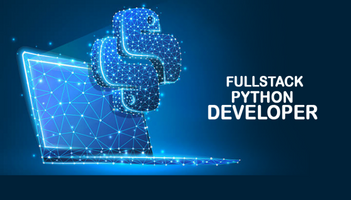Step-by-Step Guide to Full Stack Development with Python
What is Full Stack Development?
full stack development python refers to the practice of developing both the frontend (client-side) and backend (server-side) of web applications. A Full Stack Developer is proficient in multiple technologies and can handle every aspect of the development process.
Importance of Full Stack Development
Full Stack Developers are highly sought after in the tech industry due to their ability to work on all layers of an application. They can create complete, functional products independently or as part of a team
Understanding Python for Full Stack Development
Why Choose Python for Full Stack Development?
Python's simplicity, readability, and vast ecosystem of libraries make it an ideal choice for Full Stack Development. Its flexibility allows developers to build scalable web applications efficiently.
Basic Concepts of Python
Before diving into Full Stack Development, it's essential to have a solid understanding of Python fundamentals such as data types, control flow, functions, and object-oriented programming.
Frontend Development with Python
Introduction to Frontend Development
Frontend Development involves creating the user interface and user experience of web applications. Python offers several frameworks and tools for frontend development, including Django and Flask.
Tools and Frameworks for Frontend Development in Python
Frameworks like Django provide built-in features for frontend development, including template engines and form handling. Additionally, libraries like React and Vue.js can be integrated with Python backend to create interactive user interfaces.
Backend Development with Python
Introduction to Backend Development
Backend Development focuses on server-side logic and database management. Python's asynchronous frameworks like FastAPI and asynchronous libraries like asyncio are well-suited for building high-performance backend systems.
Tools and Frameworks for Backend Development in Python
Frameworks like Django and Flask are popular choices for building backend APIs and handling business logic. Python's extensive support for databases simplifies data management tasks.
Database Management with Python
Importance of Database Management in Full Stack Development
Efficient database management is crucial for storing and retrieving data in web applications. Python offers libraries like SQLAlchemy and Django ORM for interacting with databases.
Popular Databases Compatible with Python
Python supports various databases, including relational databases like PostgreSQL, MySQL, and SQLite, as well as NoSQL databases like MongoDB and Redis.
Integrating Frontend, Backend, and Database with Python
Bringing It All Together
Full Stack Developers use Python to integrate frontend, backend, and database layers seamlessly. Frameworks like Django provide built-in features for handling requests, processing data, and rendering templates.
Best Practices for Integration
Following best practices such as separating concerns, using RESTful APIs, and implementing security measures ensures a robust and maintainable application architecture.
Testing and Debugging in Full Stack Development
Importance of Testing and Debugging
Testing and debugging are essential aspects of software development to ensure the reliability and functionality of web applications. Python offers testing frameworks like pytest and debugging tools like pdb.
Tools and Techniques for Testing and Debugging
Automated testing, unit testing, and integration testing help identify and fix bugs early in the development process. Debugging tools like breakpoints and logging assist in troubleshooting issues efficiently.
Deployment and Maintenance
Deploying Full Stack Applications
Deploying a Full Stack Application involves configuring servers, setting up databases, and managing dependencies. Platforms like Heroku and AWS provide deployment solutions tailored for Python applications.
Strategies for Maintenance and Updates
Regular maintenance, updates, and monitoring are essential for keeping Full Stack applications secure and performing optimally. Continuous integration and deployment (CI/CD) pipelines automate the deployment and update process.
Advantages and Challenges of Full Stack Development with Python
Advantages
- Versatility: Python's versatility allows developers to work on both frontend and backend aspects of applications.
- Efficiency: Python's concise syntax and vast ecosystem of libraries streamline the development process.
- Community Support: Python has a large community of developers who contribute to open-source projects and provide support.
Challenges
- Scalability: As applications grow in complexity, scaling Python-based systems may require additional optimization and infrastructure.
- Security: Ensuring the security of Full Stack applications requires implementing best practices for data protection and authentication.
- Learning Curve: Mastering Full Stack Development with Python requires learning multiple technologies and frameworks, which can be challenging for beginners.
Getting Started with Full Stack Development Training
Resources for Learning Full Stack Development with Python
Online tutorials, documentation, and coding boot camps offer comprehensive resources for learning Full Stack Development with Python. Platforms like Coursera, Udemy, and Code academy provide structured courses for beginners and experienced developers alike.
Full Stack Development Courses and Training Programs
Formal education programs and certifications in Full Stack Development equip aspiring developers with the skills and knowledge needed to succeed in the field. Universities, coding schools, and online academies offer Full Stack Development courses tailored for different skill levels.
Career Opportunities as a Full Stack Python Developer
Job Roles and Responsibilities
Full Stack Python Developers can pursue various roles, including Full Stack Engineer, Web Developer, Software Engineer, and Technical Lead. Responsibilities may include designing, developing, and maintaining web applications, as well as collaborating with cross-functional teams.
Salary Trends and Growth Opportunities
Full Stack Python Developers are in high demand across industries

.png)

Comments
Post a Comment